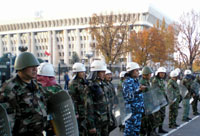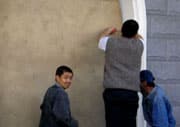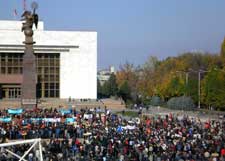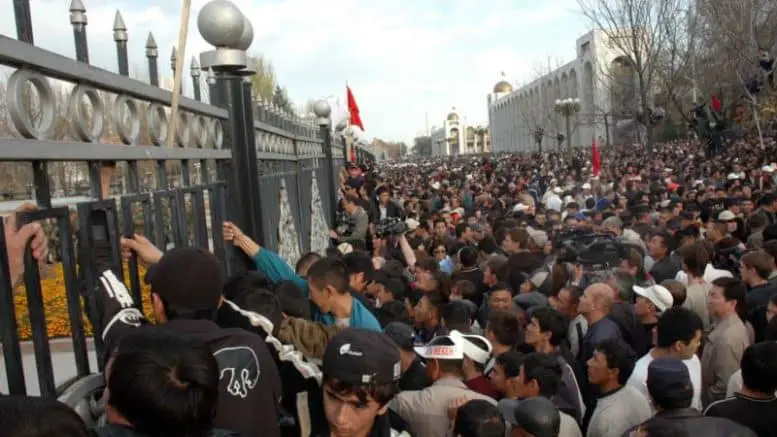
Riot Police Outside the Kyrgyz White House
The March 2005 overthrow of President Askar Akayev in Kyrgyzstan did not immediately revolutionize Kyrgyz politics. The Kyrgyz people initially heralded their “Tulip Revolution,” but the intervening 18 months proved that a forced change of leadership is somewhat easier to bring about than sustained economic and political development. It was the same frustration over the lack of improvement in wages and social services and the seeming replication of graft and corruption at the highest levels of government which had originally helped sweep Kurmanbek Bakiyev into power in 2005 that allowed the opposition “For Reform” movement to gain momentum in the fall of 2006.
The Tulip Revolution occured in March 2005, when a political gathering exploded into violence. With the government ill-prepared for thousands of demonstrators and the ensuing nighttime rioting, shops were looted and burned and police even threw off their uniforms and joined in the spree. Organized crime got into the act as well – arming its thugs better than most security forces in the capital – to help further despoil the city. President Akayev was forced to resign and flee the country. Opposition leaders supported by the protesters took over power.
Since then, a new and motley opposition – composed of green party environmentalists, blue party Ar-Namys (Dignity) members, and others, as well as the rose-colored Social Democratic umbrella party – have also held several rallies demanding essentially the same reforms demanded durring the previous protests. However, meetings in March and April of 2006 were tamped down by rain. November, with clear weather and increasing displeasure with the administration, seemed to forebode something more and while many in Bishkek hoped for reform, they also feared a return of violence.

Kyrgyz boarding a window to a shop before the protests
Bishkek residents began preparations for the influx of thousands of people from the countryside on Monday, October 30th. Many who could leave town, did so. Businesses and institutions, including The American University – Central Asia, located next to Parliament, announced closures during the first two days of the meeting. Like Washingtonians petrified by the first annual snow, Bishkek residents stocked up on essentials of food and water. Other measures were postponed until the last minute. One shop owner spent the night of the 31st frantically packing up his inventory of shoes into his car, as if he expected the Confederate Army to arrive the next day. Rumors had spread that all the gun stores in Bishkek were sold out and organized crime was ready to rampage.
Those that populate these political rallies are mostly impoverished residents from rural areas brought in by local politicians and businessmen. Often, the poor farmers have only two choices: take the daily allowance of around 400 som ($10) and demonstrate, or lose what is nearly a fifth of Kyrgyzstan’s average monthly wage and show up anyway under threat. Vodka is usually distributed as well to maintain a fighting spirit during the day’s long-winded speeches.
Leaving my apartment armed with just keys, camera and a copy of my passport, I braced for visions of marauding youths and baton-wielding security forces. Instead, just two blocks from the White House children played outside and people seemed blithely unaware that a protest-cum-revolution was in progress. Once I arrived on the front steps of Parliament I scanned the crowd for signs of impending turmoil. However, with just a few hundred mild protesters out, the most excitement at midday November 2, was the crack of a soldier dropping his riot shield on the ground.

Omurbek Tekebaev at the protests
My camera and white complexion apparently qualified me for the press pool as I approached the stands, so when oppostion leader Omurbek Tekebaev finally emerged from Parliament, I was just feet away. A former speaker (and now deputy), Tekebaev’s appearance seemed to galvanize the crowd. However, once we marched to Ala-Too square in the very heart of Bishkek, the speeches resumed and the protesters’ immediate fervor diminished. As Thursday’s rally wound on, much of the fear expressed by locals seemed unwarranted. The admonition to foreigners to stay locked up at home, or to only venture out flanked by Kyrgyz, seemed clearly unnecessary – and ignored by many as even a Western diplomat or two could be seen in the crowd.
In fact, some of the best news from the first days of protests may have had nothing to do with the opposition’s demand for business reform, a constitutional revision, an end to corruption, or enhanced separation of powers. Less grandiose, but perhaps more important, the first days of November saw the maturation of a democratic Kyrgyz nation. The government of Kurmanbek Bakiyev was certainly prepared for a large gathering. Internal security forces numbered in the hundreds and police were equipped with non-lethal crowd control gear such as shields, body armor, and batons, as well as a few grenade launchers for tear gas and flashbangs. Water cannon trucks stood by as well, though I only counted a total of three such vehicles. However, the government neither interfered with, nor provoked the demonstrators. Likewise, the entire rally proceeded peacefully. The only unrest in the center of Bishkek occurred when several police requested that protesters move one of their tents a few feet to the side.
After the first days of protesting, singing and speeches on the main square and in front of Parliament, the reformers seemed to be losing steam. Yet despite a dwindling number of protesters on Ala-Too square, the reformers vowed to continue camping out in central Bishkek until Bakiyev aceeded to their demands. Meanwhile, Bakiyev’s government may have been losing patience with the continued presence of opposition around the White House and Parliament. It is somewhat fitting then that on the anniversary of the Bolshevik Revolution, November 7, violence broke out in Bishkek between those in power and those in opposition as a brief clash saw the groups hurling stones and bottles of drinking water at each other. Security forces responded promptly, and in moderation, launching several canisters of tear gas to disperse the protesters who had advanced from Ala-Too square on a small group of government loyalists (also likely hired by wealthy people in power), who were demonstrating in front of Parliament. Yet it all ended relatively peacefully.

Protesters at Alma-Atu Square
The brief spark of violence may have helped propel the compromise between reformers and the Bakiyev government. The following evening, deputies hurriedly read a draft proposal for a new constitutional law, which Bakiyev promptly signed on November 9. The new constitutional order will evolve gradually, and many changes are not expected to come into play until 2010. Still, Kyrgyzstan managed to avoid some pitfalls and move from being the only democracy in Central Asia to being the only parliamentary-presidential democracy in the region. The new constitution will allow political party majorities in Parliament to form a government. It also changes how members of the assembly, due to be enlarged from 75 to 90 deputies, are selected; a mixed voting system will also allow for 50 percent of the assembly’s seats to be apportioned by party lists. Furthermore, the National Security Service will be placed under control of the prime minister rather than the president. In short, the government of Kyrgyzstan has become more heterogeneous, with more parties able to gain real representation and a more regulated separation of power.
The fear induced by this political rally is at odds with democratic norms in the West, but the behavior of the government and the political activists – political rhetoric aside – was certainly a step in the right direction. As my young Kyrgyz friend Askhat remarked when I asked him about the possibility of violence along the lines of 2005, “This isn’t Uzbekistan.” In Andijan – a town in eastern Uzbekistan, Islam Karimov’s government forces had massacred hundreds and perhaps thousands of protesters on May 13, 2005.
Some demonstrators in Bishkek may have showed up for the payouts and free vodka, but this is hardly worse than much of the patronage offered by American politicians just a century ago. Given that Kyrgyzstan has only had some 15 years of independence, no history of democratic institutions, and only a slim understanding of itself as a modern nation-state, the recent political developments in the country should definitely be appreciated as democratic advances in a part of the world that has shown itself otherwise resistant to such progress.


